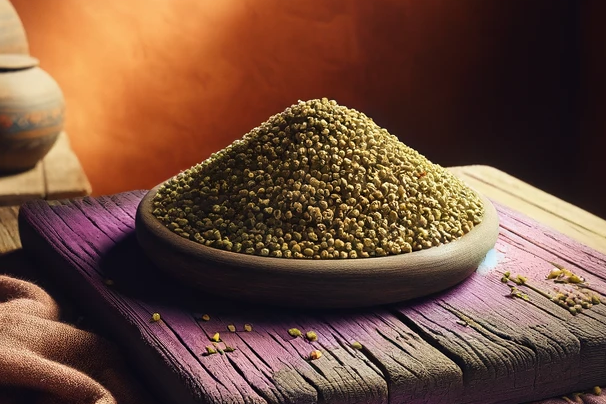Bulgur

What is bulgur?
Bulgur is a cereal product made from durum wheat semolina. To make bulgur, the semolina is soaked, cooked with steam, dried again and the husks removed. The remaining grains are then coarsely or finely ground and packaged.
Bulgur originates from the Middle East and is a staple food there. It is often used for dishes such as taboulé, pilaf or kofta. Bulgur has a slightly nutty and tangy taste and is quick and easy to prepare. It only needs to be soaked in hot water for a few minutes until it swells.
Is bulgur safe for dogs?
The tolerance of bulgur for dogs depends on various factors, such as the amount, frequency and individual sensitivity of the dog. As a general rule, cereals are not a natural part of a dog's diet and should therefore only be fed in small quantities and as a supplement to meat.
Bulgur is a durum wheat product that often contains gluten. Gluten is a gluten protein that can lead to intolerances or allergies in some dogs. Typical symptoms are itching, skin rash, diarrhea or vomiting. If your dog has a gluten intolerance or allergy, you should not give him bulgur.
Even if your dog has no problem with gluten, he may still be sensitive to bulgur. This is because grains are difficult for dogs to digest and lack the digestive enzymes to break them down effectively. This can lead to bloating, abdominal pain or indigestion.
In addition, too much grain in dog food can lead to an oversupply of carbohydrates, which in turn can contribute to obesity, diabetes or other metabolic problems.
Does bulgur have benefits for dogs?
Bulgur also has some benefits for dogs when fed in moderation. It contains many nutrients such as iron, magnesium, fiber, B vitamins and vegetable protein. These can support a dog's health, for example in terms of blood formation, muscle function, digestion and the immune system.
Bulgur can also be used as a light diet for dogs, for example if they suffer from gastrointestinal problems or have to take medication. It is easy to digest and keeps you full for a long time. It can be mixed with some cooked chicken or quark to provide a balanced meal.
Bulgur can also be an alternative for dogs that are allergic to animal protein. In this case, you can offer them vegetable protein from cereals or pulses. However, you should make sure that the dog still gets enough high-quality protein and not too many carbohydrates.
How do you feed bulgur to dogs?
If you want to feed your dog bulgur, there are a few things you should bear in mind:
- Feed only small amounts and not too often. One to two tablespoons per day is sufficient for a medium-sized dog.
- Always cook the bulgur beforehand and soak it in hot water. Raw bulgur is indigestible and can cause stomach irritation.
- Only use unseasoned and unsalted bulgur. Spices and salt can be harmful to dogs and lead to poisoning or kidney damage.
- Always mix the bulgur with some meat or other high-quality protein. Grain alone is not a complete dog food and can lead to deficiency symptoms.
- Observe how your dog reacts to the bulgur. If it shows signs of intolerance or allergy, stop feeding it immediately.
Bulgur is an oriental cereal product made from durum wheat semolina. It has a nutty taste and a grainy consistency. It contains many nutrients such as iron, magnesium, fiber, B vitamins and vegetable protein.
Bulgur can be tolerated by dogs if it is fed in small quantities and as a supplement to meat. It can be used as a light diet or as an alternative for dogs with animal protein allergies.
However, bulgur can also be intolerable or harmful to dogs if it is fed too often or too much. It can contain gluten, which can lead to intolerances or allergies in some dogs. It can also be difficult to digest and lead to bloating, abdominal pain or indigestion. It can also lead to an oversupply of carbohydrates, which in turn can contribute to obesity, diabetes or other metabolic problems.
If you want to feed your dog bulgur, there are a few things you should bear in mind: Feed only small amounts and not too often. Always cook the bulgur beforehand and soak it in hot water. Only use unseasoned and unsalted bulgur. Always mix the bulgur with some meat or other high-quality protein. Observe how your dog reacts to the bulgur.
Bulgur is not a natural part of a dog's diet and should therefore only be fed in moderation. The majority of your dog's diet should consist of meat that meets his needs as a carnivore.
Properties 9
Are you looking for other ingredients with a specific property?
Just click on them to find more.
If you notice any signs of hypersensitivity or poisoning in your dog, you should see your vet immediately. We are not a substitute for a vet, but we try to be as accurate as possible. Every dog reacts differently and we recommend you get a second opinion or consult your vet if in doubt.
Stay healthy and take good care of your four-legged friend!😊
Similar to Bulgur
Couscous is a cereal product made from durum wheat semolina. The semolina is mixed with water and salt and formed into small balls, which are then dried. To prepare couscous, simply soak it in...
Quinoa is a plant from the foxtail family that grows in the Andes. The seeds of the plant are known as quinoa and are similar in shape and consistency to rice or couscous. Quinoa is gluten-free and...
Farro is a collective term for three different types of wheat: einkorn, emmer and spelt. They all originate from Mesopotamia and have been cultivated for thousands of years. Farro is often referred...
Frekeh (also known as Farīk, Frikeh, Frique, Frik, Fireek, Freeky, Firik or Freek) is a cereal product made from unripe harvested and roasted durum wheat. The wheat is harvested when it is still...



